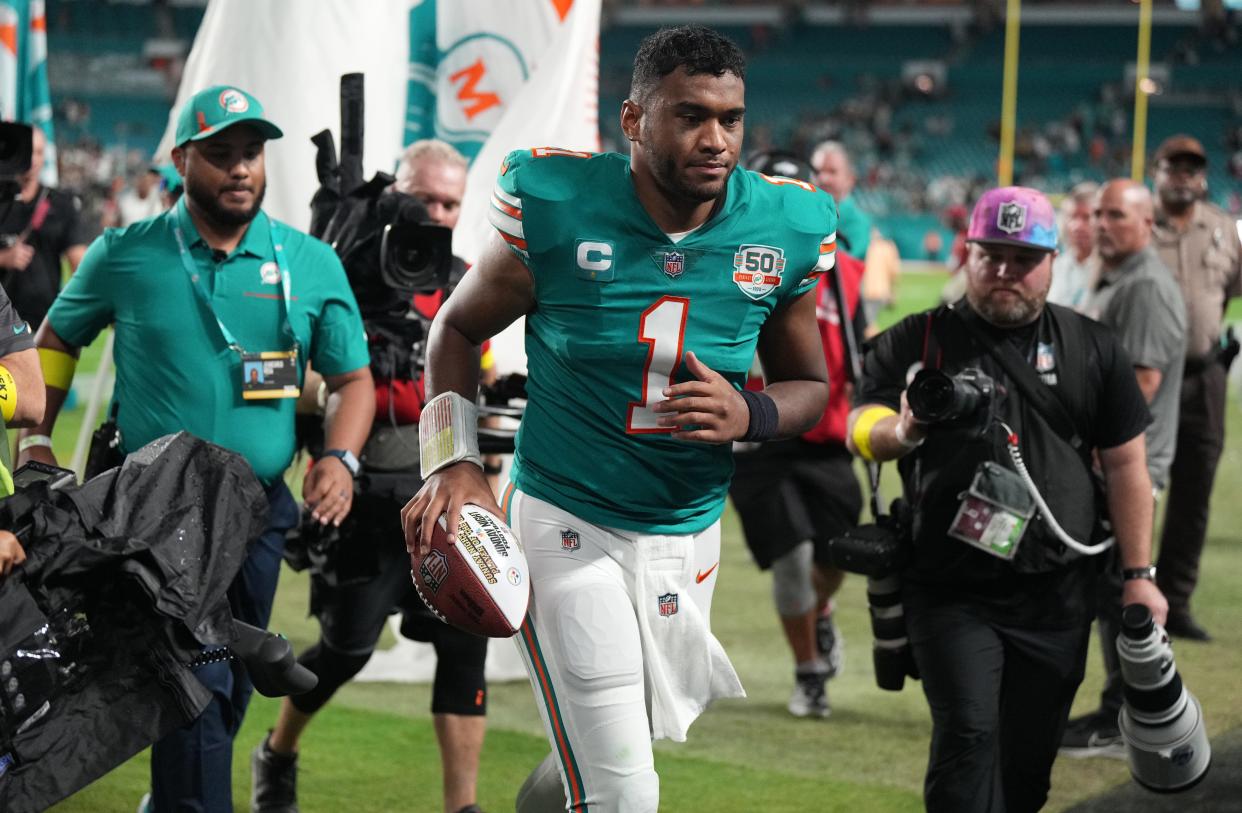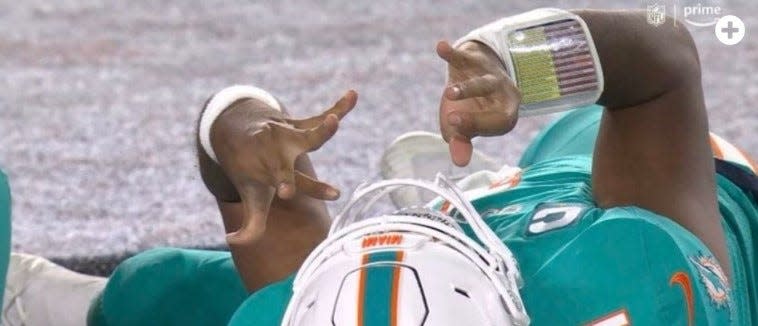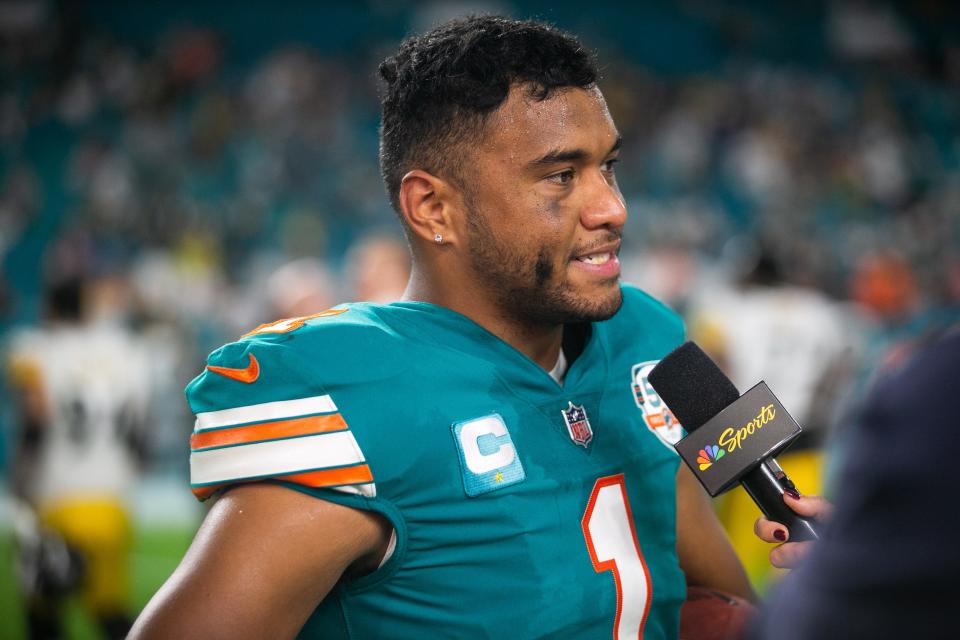A fan's fear for quarterback Tua Tagovailoa: 'I can't watch — but I can't look away'

- Oops!Something went wrong.Please try again later.
There’s a knot in my stomach.
My chest feels constricted.
As I stare nervously at the TV screen, I can feel myself unconsciously “body English” our hero out of harm’s way.
Am I streaming a recently released suspense movie?
No — I’m watching Miami Dolphins quarterback Tua Tagovailoa make his return to game action against the Pittsburgh Steelers after suffering a horrific concussion on Sept. 29 in Cincinnati. The image of an unconscious Tagovailoa being carted off the field — with his fingers stiffly twisted in front of his face in the so-called “fencing response” — transcended sports and became a topic of discussion on the national morning talk shows.
More on Tagovailoa's return: Dolphins' Mike McDaniel wants Tua Tagovailoa to use caution, ‘concede' when plays break down
More Health Matters: Health Matters: Why men need to know their family history with breast cancer
That incident came just four days after Tagovailoa’s head was banged into the turf at the end of the first half of a game against Buffalo at Hard Rock Stadium. Tagovailoa could be seen holding his head, shaking it a couple of times and then attempting to run upfield for the next play.
But Tagovailoa started stumbling, went rubbery-kneed, and needed to be propped up by teammates. He was removed from the game and evaluated for a concussion — but returned to play in the second half. He never entered the league’s concussion protocol.

Experts call the stumbling, listing gait Tagovailoa demonstrated in the Buffalo game “gross motor instability” — a classic indication of concussion and now deemed a “no-go" for return to play for any NFL player displaying such symptoms.
Uncharted territory for lifelong fan
I’ve been a Miami Dolphins fan for more than 50 years.
Perhaps my earliest memory in life is, as a 5-year-old, attending my first game in the Orange Bowl in 1970 (Don Shula’s first season as head coach). Indeed, I remember every one of the (now elderly) surviving players from the 1972 undefeated team who were honored on Oct. 23 — and I’ve never felt so conflicted viewing a football game as I did seeing Tagovailoa suit up against the Steelers.
I can’t watch. But I can’t look away.
And on two specific occasions when Tagovailoa, as a ball carrier, lowered his shoulder — and initiated contact with a defender — I held my breath and thought: “Tua, what are you doing? Don’t do that again!”
Concussions: Shrouded in mystery
As a middle-aged man, for me to enjoy football while trying to ignore the inherent long-term health risks — especially brain-related ones — that all players face means mentally contorting myself into a pretzel-like state of cognitive dissonance.
Yes, I know these fearless young men are doing what they love, and those with the ability to play professionally are remunerated handsomely for the risks they take.
But concussions are a fact of life in football — a matter of when, not if.
According to the Mayo Clinic "a concussion is a traumatic brain injury that affects brain function. Effects are usually temporary but can include headaches and problems with concentration, memory, balance and coordination."
Concussions usually occur in one of two ways: 1) a direct blow to the head; or 2) some other part of the body absorbs an impact, creating a violent whiplash effect on the head. Concussions are graded by severity, and their symptoms — such as dizziness, nausea, vomiting, confusion, amnesia, impaired speech, disparate pupil size, etc. — vary.
But there's one thing all experts will tell you: There's no such thing as a “mild” concussion. Furthermore, we now know that concussions occur even when there's no loss of consciousness (making many of them undiagnosed). We also know that susceptibility is progressive — especially if the after-effects of a previous concussion have not fully dissipated.
The long-term effects of suffering multiple concussions — not to mention Tagovailoa’s (de facto) two in four days! — are impossible to predict.
Even in the short-term, we know that no two concussions are alike, that how any individual will respond to any given concussion is utterly capricious.
After all, there is no treatment protocol for a concussion. Whether one is a world-class athlete or an everyday citizen, neurologists will recommend a patient simply wait for the symptoms to subside and slowly return to normal activities.
And if those activities result in a return of symptoms, a person must stop them immediately.
Some athletes return from a concussion in a matter of weeks like Tagovailoa did; others are sidelined for months on end with lingering symptoms that might include, but are not limited to, nausea, headaches, dizziness, sensitivity to light, inability to concentrate, depression, etc. — i.e., post-concussion syndrome.
Increased risk for CTE
Since the mid-2000s, we’ve known how high the risk is for football players to develop chronic traumatic encephalopathy (CTE) — a condition in which the brain becomes overrun by dark brown tangles of tau protein, which is thought to potentially lead to memory loss, depression, changes in personality, dementia and ALS-like symptoms, among others.
In the weeks following the incident in Cincinnati, Tagovailoa visited multiple neurological trauma experts nationwide and was cleared by all of them to return to action.
He also believes that because, as a quarterback, he doesn’t absorb the “sub-concussive” contact on every play the way players at other positions do, he’s somewhat protected from a worst-case long-term scenario.

"Let’s say guys get about six concussions," Tagovailoa said to The Palm Beach Post. "Well, those guys that only have six concussions that are playing the position that I’m playing, where we don’t hit as much, are less susceptible to getting CTE later on in their years than someone who’s playing a position where they’re constantly taking hits or blows to the head, which would be O-line, D-line, linebackers."
Tagovailoa’s points are well-taken; but it should also be noted that Hall of Fame quarterbacks Roger Staubach, Steve Young and Troy Aikman all had their playing careers cut short by the cumulative effects of concussions.
Heck, even Tom Brady’s currently estranged wife, Giselle Bündchen, spoke in 2017 about her husband’s history of multiple concussions — even though the future Hall of Famer has never appeared on an official injury report with a concussion.
Long season ahead
Tagovailoa made it through the Dolphins’ narrow 16-10 victory over the Steelers unscathed.
He wasn’t sacked, but those two plays in which he sought contact rather than avoid it as he could have showed us he has no intention of altering his playing style in order to perhaps avoid future injury.
There are 10 games left in the Dolphins regular season — which means countless more chances for him to get hit.
And you can bet that EVERY time Tagovailoa absorbs contact, I’ll be holding my breath until he arises uninjured — and in full possession of all his faculties.
This article originally appeared on Palm Beach Post: Tua Tagovailoa: Columnist winces as Dolphins' quarterback returns to play

